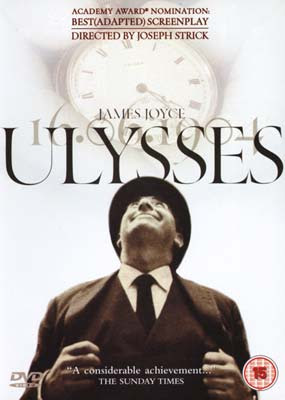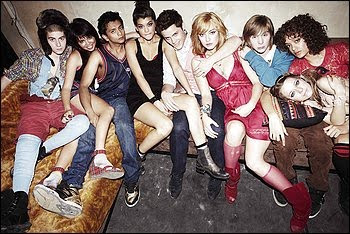 Cohen v. California freedom of speech case
Cohen v. California freedom of speech case Ulysses: first movie to drop F-bomb
Ulysses: first movie to drop F-bomb French Connection: profanity for profit
French Connection: profanity for profitIt's about that time to explore another beloved term for "Vice Pioneers." We've already uncovered "Cunt" so this week we go after the second most profane word in the English language. "Fuck" is a special word though. While "cunt" is shocking and all, it has limited meaning and can only be used in special occasions. Fuck on the other hand is the most versatile word, with the ability to be used as a noun, verb, adjective, etc. The word has a vague origin, but there is still plenty of history surrounding the word.
From
Wikipedia: Fuck is an English word that is generally considered profane which, in its most literal meaning, refers to the act of sexual intercourse. However, by extension it may be used to negatively characterize anything that can be dismissed, disdained, defiled, or destroyed.
"Fuck" can be used as a verb, adverb, adjective, command, interjection, noun, and can logically be used as virtually any word in a sentence (e.g., "Fuck the fucking fuckers"). Moreover, it is one of the few words in the English language which could be applied as an infix (e.g., "Am I sexy? Absofuckinglutely!"; "Bullfuckingshit!"). It has various metaphorical meanings. The verb "to be fucked" can mean "to be cheated" (e.g., "I got fucked by a scam artist"), or alternatively, to be sexually penetrated. As a noun "a fuck" or "a fucker" may describe a contemptible person. "A fuck" may mean an act of copulation. The word can be used as an interjection, and its participle is sometimes used as a strong emphatic. The verb to fuck may be used transitively or intransitively, and it appears in compounds, including fuck off, fuck up, "fuck you", and fuck with. In less explicit usages (but still regarded as vulgar), fuck or fuck with can mean to mess around, or to deal with unfairly or harshly. In a phrase such as "don't give a fuck", the word is the equivalent of "damn", in the sense of something having little value. In "what the fuck!", it serves merely as an intensive. If something is very abnormal or annoying "this is fucked up!" may be said.
Etymology
The Oxford English Dictionary states that the ultimate etymology is uncertain, but that the word is "probably cognate" with a number of native Germanic words with meanings involving striking, rubbing, and having sex.
Flen flyys and freris
The usually accepted first known occurrence is in code in a poem in a mixture of Latin and English composed some time before 1500. The poem, which satirizes the Carmelite friars of Cambridge, England, takes its title, "Flen flyys", from the first words of its opening line, Flen, flyys, and freris (= "Fleas, flies, and friars"). The line that contains fuck reads Non sunt in coeli, quia gxddbov xxkxzt pg ifmk. Removing the substitution cipher (here, replacing each letter by the next letter in alphabetical order, as the English alphabet was then) on the phrase "gxddbov xxkxzt pg ifmk" yields non sunt in coeli, quia fvccant vvivys of heli, which translated means, "They are not in heaven because they fuck wives of Ely". The phrase was coded likely because it accused some Church personnel of misbehaving; it is uncertain to what extent the word fuck was considered acceptable at the time. (The stem of fvccant is an English word used as Latin: English medieval Latin has many examples of writers using English words when they did not know the Latin word: "workmannus" is an example.) (In the Middle English of this poem, the term wife was still used generically for woman.)
John le Fucker
A man's name, "John le Fucker", is said to be reported from AD 1278, but the report is doubtful: an email discussion on Linguist List says:
"This name has been exhaustively argued over ... The "John le Fucker" reference first appears in Carl Buck's 1949 Indo-European dictionary. Buck does not supply a citation as to where he found the name. No one has subsequently found the manuscript in which it is alleged to have appeared. If the citation is genuine and not an error, it is most likely a spelling variant of "fulcher", meaning soldier."
False etymologies
One reason that the word fuck is so hard to trace etymologically is that it was used far more extensively in common speech than in easily traceable written forms. There are several urban-legend false etymologies postulating an acronymic origin for the word. None of these acronyms were ever heard before the 1960s, according to the authoritative lexicographical work The F-Word, and thus are backronyms. In any event, the word fuck has been in use far too long for some of these supposed origins to be possible. Some of these urban legends are that the word fuck came from Irish law. If a couple were caught committing adultery, they would be punished "For Unlawful Carnal Knowledge In the Nude", with "FUCKIN" written on the stocks above them to denote the crime. Another theory is that of a royal permission. During the Black Death in the Middle Ages, towns were trying to control populations and their interactions. Since uncontaminated resources were scarce, many towns required permission to have children. Hence, the legend goes, that couples that were having children were required to first obtain royal permission (usually from a local magistrate or lord) and then place a sign somewhere visible from the road in their home that said "Fornicating Under Consent of King", which was later shortened to "FUCK". This story is hard to document, but has persisted in oral and literary traditions for many years; however, it has been demonstrated to be an urban legend.
The word "fuck" did not come from any of the following:
"File Under Carnal Knowledge"
"Fornication Under the Christian King"
"Fornication Under the Command of the King"
"Fornication Under the Consent of the King"
"Fornication Under Carnal/Cardinal Knowledge"
"False Use of Carnal Knowledge"
"Felonious Use of Carnal Knowledge"
"Felonious Unlawful Carnal Knowledge"
"Full-On Unlawful Carnal Knowledge"
"For Unlawful Carnal Knowledge"
"Found Under Carnal Knowledge"
"Found Unlawful Carnal Knowledge"
"Forced Unlawful Carnal Knowledge" (referring to the crime of rape)
Usage history
Early usage
Its first known use as a verb meaning to have sexual intercourse is in "Flen flyys", written around 1475.
William Dunbar's 1503 poem "Brash of Wowing" includes the lines: "Yit be his feiris he wald haue fukkit: / Ye brek my hairt, my bony ane" (ll. 13–14).
John Florio's 1598 Italian-English dictionary, A Worlde of Wordes, included the term, along with several now-archaic, but then vulgar synonyms, in this definition:
Fottere: To jape, to sard, to fucke, to swive, to occupy.
Of these, "occupy" and "jape" still survive as verbs, though with less profane meanings, while "sard" was a descendant of the Anglo-Saxon verb seordan (or seorðan, serða), to copulate; and "swive" had derived from earlier swīfan, to revolve i.e. to swivel.
While Shakespeare never used the term explicitly; he hinted at it in comic scenes in a few plays. The Merry Wives of Windsor (IV.i) contains the expression focative case. In Henry V (IV.iv), Pistol threatens to firk (strike) a soldier, a euphemism for fuck.
Rise of modern usage
Though it appeared in John Ash's 1775 A New and Complete Dictionary, listed as "low" and "vulgar," and appearing with several definitions, fuck did not appear in any widely-consulted dictionary of the English language from 1795 to 1965. Its first appearance in the Oxford English Dictionary (along with the word cunt) was in 1972. There is anecdotal evidence of its use during the American Civil War.
Censorship
The films Ulysses and I'll Never Forget What's'isname (both 1967) are contenders for being the first film to use the word 'fuck,' although the word 'fucking' is clearly mouthed silently in the film Sink the Bismarck! (1960), and the title character says it in the cartoon Bosko's Picture Show (1933). Since the U.S. adoption of the MPAA film rating system, use of the word has been accepted in R-rated movies, and under the older rules, use of the word in a sexual way would automatically cause the film to be given an R rating. Later changes could allow for a maximum of three, non-sexual, strictly exclamatory uses of the word in PG-13 movies, extreme example being the movies The American President and Nine Months (this is more of a guideline than a rule, however, since the MPAA states it has no strict rules on how a movie is rated).
In 1970, Beatle John Lennon successfully got the word past the censors on his song "Working Class Hero" with the lines "They hate you if you're clever and they despise a fool, till you're so fucking crazy you can't follow their rules" and "You think you're so clever and classless and free, but you're still fucking peasants as far as I can see."
Since the 1970s, the use of the word "fuck" in R-rated movies has become so commonplace in mainstream American movies that it is rarely noticed by most audiences. Nonetheless, a few movies have made exceptional use of the word, to the point where such films as Fuck, Good Will Hunting, Casino, The Last Detail, Menace II Society, The Big Lebowski, The Departed, Scarface (1983), Pulp Fiction, Blue Velvet, South Park: Bigger, Longer & Uncut, and Goodfellas as well as the HBO TV series The Sopranos are known for its extensive use. In the movie Meet the Parents, and its sequels Meet the Fockers and Little Fockers, the main character's last name of "Focker" is a running joke. In the popular comedy Four Weddings and a Funeral, it is the chief word, repeatedly uttered, during the opening five minutes. To many, one of the most humorous tirades demonstrating various usages of the word appears in the comedy, Planes, Trains & Automobiles (1987), where Steve Martin expresses his dissatisfaction in his treatment by a rental car agency. The movie Student Bodies inserted a scene in the middle of the film to explain to audiences that movies with an R rating are more popular than those carrying a PG rating, which the movie could easily have had. He ends his address with, " ... the producers of this motion picture have asked me to take this opportunity to say 'Fuck you'.", at which time the MPAA R-rating banner appeared.
In several PG-rated movies, however, the word is used, mainly because at the time there was no PG-13 rating and the MPAA did not want to give the films R ratings; for instance, All the President's Men (1976), where it is used seven times; The Kids Are Alright (1979), where it is used twice; and The Right Stuff (1983), where it is used five times. Spaceballs (1987) is one of at least four anomalies in that it was rated PG after the 1984 introduction of the PG-13 rating, yet it includes Dark Helmet's line, "'Out of order'?! Fuck! Even in the future nothing works!" The second is Big (1988) which has the character of Billy asking Tom Hanks' character, "Who the fuck do you think you are?" The third is Beetlejuice (1988) which has the character Betelgeuse kick over a fake tree and scream, "nice fucking model!" The fourth is 1988's Caddyshack II where Randy Quaid's character shouts out he is going to break down a door with a "fucking baseball bat."
In the 1999 film "Galaxy Quest," Sigourney Weaver's character Gwen DeMarco is edited from the line "Well, fuck that!" to "Well, screw that!" The change was made to avoid a PG-13 rating, and the original line is obvious when reading her lips.
Films edited for broadcast use matching euphemisms so that lip synching will not be thrown off. One televised version of Quentin Tarantino's Jackie Brown, for instance, had the actors dub in the words frick, Nubian, and melon farmer for fuck, nigger, and motherfucker, respectively. In similarly dubbed versions of Die Hard and Die Hard 2, Bruce Willis' catchphrase "Yippee-ki-yay, motherfucker" is replaced by "Yippee-ki-yay, Mister Falcon" or "Yippee-ki-yay, Kemo Sabe." Similarly, the TV broadcast edit of Snakes on a Plane has Samuel L. Jackson saying "I have had it with these monkey-fighting snakes on this Monday-to-Friday plane", emending two occurrences of motherfucking. In the film The Big Lebowski, John Goodman's character repeatedly yells, "This is what happens when you fuck a stranger in the ass" while trashing a car. It was infamously censored on television as "This is what happens when you find a stranger in the Alps." His character also repeatedly says to Steve Buscemi's character, "Shut the fuck up, Donny," or "Donny, shut the fuck up." In the television version, fuck is censored with hell.
Many stand-up comedians who perform for adult audiences make liberal use of the word fuck. While George Carlin's use of the word was an important part of his stage persona, other comedians (such as Andrew Dice Clay) have been accused of substituting vulgarity and offensiveness for genuine creativity through overuse of the word. Billy Connolly and Lenny Bruce were pioneers of the use of the word in their shows for general audiences.
Recently, the hip-hop group Black-Eyed Peas' hit song "Don't Phunk With My Heart" was censored on many radio stations to "Don't Mess With My Heart", establishing a new trend toward eliminating all euphemisms for "fuck" as well as the word itself. James Blunt's first major song, You're Beautiful, featured the line "she could see from my face that I was fucking high" - this was censored to "flying high" for broadcasting purposes.
Use in marketing
In April 1997, clothing retailer French Connection began branding their clothes "fcuk" (usually written in lowercase). Though they insisted it was an acronym for French Connection United Kingdom, its similarity to the word "fuck" caused controversy. French Connection fully exploited this and produced an extremely popular range of t-shirts with messages such as "fcuk this", "hot as fcuk", "mile high fcuk", "fcuk me", "fcuk her", "too busy to fcuk", "fcuk football", "fcuk fashion", "fcuk fear", "fcuk on the beach", "the joy of fcuk", etc.
In 2009, the European Union's OHIM trade marks agency disallowed a German brewery to market a beer called "Fucking Hell". They sued, and on 26 March 2010 got permission to market the beer. They claim the beer is actually named after the Austrian village Fucking and the German term for light beer, hell.
Freedom of expression
In 1971, the U.S. Supreme Court decided that the mere public display of fuck is protected under the First and Fourteenth Amendments and cannot be made a criminal offense. In 1968, Paul Robert Cohen had been convicted of "disturbing the peace" for wearing a jacket with "FUCK THE DRAFT" on it (in reference to conscription in the Vietnam War). The conviction was upheld by the Court of Appeals and overturned by the Supreme Court. Cohen v. California, 403 U.S. 15 (1971).
In 1983, pornographer Larry Flynt, representing himself before the U.S. Supreme Court in a libel case, shouted, "Fuck this court!" during the proceedings, and then called the justices "nothing but eight assholes (referring to Justices Warren E. Burger, William J. Brennan, Jr., Byron White, Thurgood Marshall, Harry Blackmun, Lewis F. Powell, Jr., William Rehnquist, and John Paul Stevens) and a token cunt" (referring to Justice Sandra Day O'Connor). Chief Justice Warren E. Burger had him arrested for contempt of court, but the charge was later dismissed on a technicality.








































